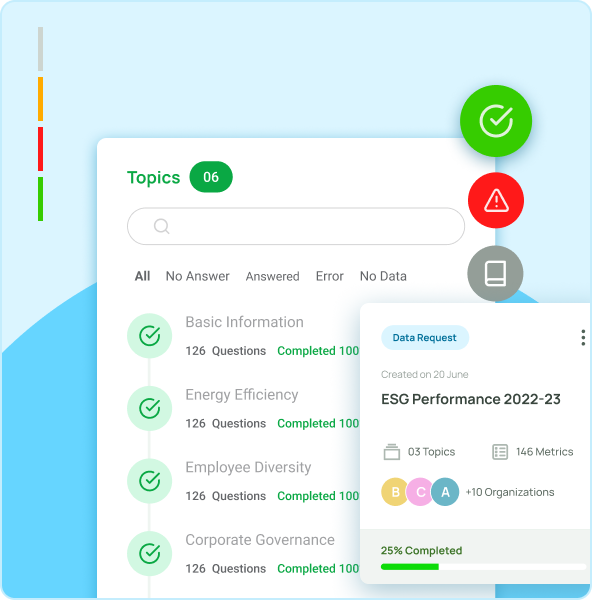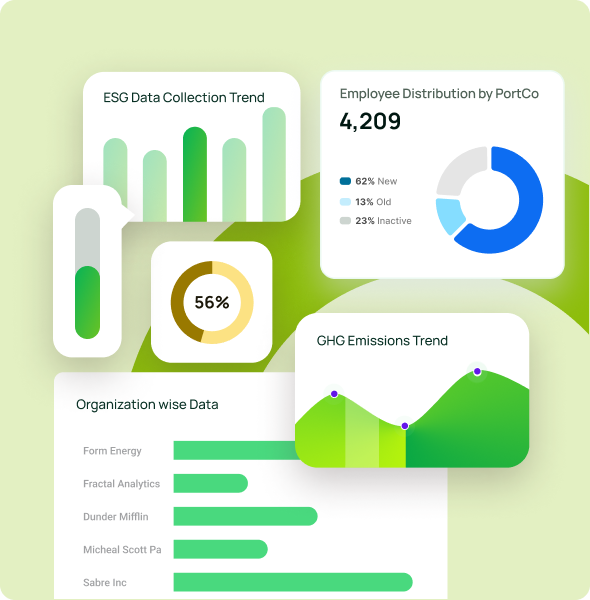The complete solution for sustainability management
We simplify and streamline ESG data collection, measurement, reporting, and analysis, so you can spend more time driving sustainable impact.
Spend less time, get more done
With all your ESG data in one place, you can instantly generate reports, dive into performance metrics, and make data-driven decisions.
Be confident in your data
Capture audit trails and automate data collection to reduce manual errors and increase transparency. Trust your numbers to stand up to the highest level of scrutiny.
Keep up with changing requirements
Adapt swiftly to evolving regulations and standards with proactive tracking and updating. Stay current, compliant, and ahead of the curve.
Take the pain out of managing your sustainability program
Transform the way you manage your sustainability and ESG processes. We handle the hard parts for you.
COLLECT
Streamline data collection
Ditch the clunky spreadsheets, endless emails, and manual data entry. Get all your sustainability and ESG metrics in one place, effortlessly.
Integrate your data sources
Seamlessly integrate with your existing business systems. Bring in data from 230+ applications, or upload files in a variety of flexible formats.

Automate your data requests
No more chasing down colleagues and partners about past-due submissions or inaccurate inputs. Pulsora’s structured workflows make it easy to scale data requests, identify errors, and streamline approvals.
A single source of truth
Spend less time sifting through spreadsheets. No matter where it’s from or what it’s for, all your sustainability and ESG data is in one place.
MEASURE
Map your carbon footprint
Seamlessly measure, manage, and mitigate emissions across all scopes to power a more sustainable future.
Delve into detailed carbon data
Dive into emissions data with pinpoint precision, from location-based specifics to individual facilities or buildings. Make informed decisions with the nuance you need.
Tailor your emission factors
Choose from established emission factors provided by IEA, UK DEFRA, US EPA, and others. Or, customize your calculations with unique factors to fit your specific needs.
Comprehensive emission accounting
Employ user-friendly calculators to measure emissions across Scopes 1, 2, and 3, ensuring accuracy and ease in every calculation.
REPORT
Prepare and file ESG disclosures with confidence
Simplify regulatory reporting, respond rapidly, and stay audit-ready with Pulsora.
Build reports, fast
Generate high-quality disclosures that meet reporting requirements from CSRD, CDP, EDCI, and more, with just a single click.
Create tailored responses
Respond to ad hoc requests quickly and accurately. Create and track custom metrics, drill down into specific data points, and build bespoke reports for any stakeholder.
Ace any audit
Rest assured with Pulsora. Know where your data comes from, track who made changes and when, and provide supporting evidence for each metric.
ANALYZE
Dive deeper into your sustainability data
Translate your ESG metrics into actionable strategies and performance benchmarks.
Get visibility into your data
See and explore your ESG and carbon data with custom dashboards. Easily access, filter, and visualize data to make better decisions, faster.
Set targets and track progress
Use predictive analytics to model different targets and outcomes, then choose the right goals and action plans for your business.
Benchmark your performance
Put your sustainability program in context. Compare your performance against industry standards such as Refinitiv, CDP, SMSCI, Sustainalytics, and more.
Built for enterprise scale

Secure and compliant
Pulsora is SOC 2 Type 2 compliant. We take extra steps to anonymize, encrypt, and safeguard your data.

Endlessly adaptable
Easily configure to fit your evolving needs, ensuring agility in achieving goals while driving performance.

Collaboration at scale
Empower your partners and affiliates to manage their ESG performance data with unlimited users.
Make sustainability and ESG your competitive advantage
Get a personalized demo with one of our sustainability policy and compliance experts.




